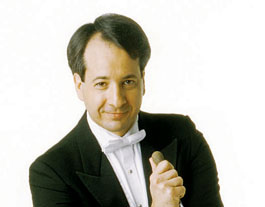home | metro silicon valley index | music & nightlife | band review

MEMORY MAN: Guest conductor Fabio Mechetti knows Beethoven by heart.
Freude Analysis
Symphony Silicon Valley showed how Beethoven synthesized new musical forms in his famous Ninth Symphony
By Scott MacClelland
IN CRAFTING Schiller's Ode to Joy in the final movement of his Ninth Symphony, Beethoven synthesized a new form using components that are commonplace in his earlier works, namely sonata form, variations and fugue. The biggest problem he needed to solve was how to reconcile the familiar symphonic forms to a strophic verse. While variations seemed the obvious answer, a movement on this scale would need greater formal architecture to free the composer's imagination and leave a more memorable result with his listeners. What he accomplished remains astonishing, as the Sunday afternoon audience at the California Theatre acclaimed with a standing O. Visiting conductor Fabio Mechetti directed Symphony Silicon Valley and Elena Sharkova's chorale in the great work after beginning the program with a moving account of Schicksalslied by Brahms. For the Beethoven, they were joined by solo singers Jane Jennings, Gigi Mitchell Velasco, Noel Espíritu Velasco and Scott Bearden.
The easiest way to track the events of the Ode to Joy is with the sonata form template: exposition, repeat, development and recapitulation. (Charles Rosen says it's a self-contained four-movement symphony.) The all-orchestral exposition begins with the cellos and basses playing the familiar tune (which Beethoven called "folk song"); the repeat begins with the bass voice first intoning the word "Freude" (Joy), which is quickly echoed by the choral basses, then the chorus in general plus the other solo singers. Both section are in variations form. The link between them calls on the solo bass to declare, "O friends, not these sounds!"—referring to the earlier three movements—"Rather let us turn to sounds more pleasant and more joyful." (Beethoven added those words as a disclaimer.) The development begins as an almost comic Turkish march, with a solo from the tenor, plus chorus, then takes off in a full symphonic fugue. As it trails off, the recapitulation explodes in choral fury as the Ode to Joy is reiterated. But then new territory is explored, a quasi fantasia in "celestial" harmony, with the final stanza of Schiller's poem, "Receive this embrace, you millions," and goes on, "Brothers, above the starry vault, a loving father must surely dwell. ... World, do you sense your Creator?" The unique introduction to the movement begins with a grinding chord on the orchestra (that would be imitated by Bruckner and Mahler in their time) and an operatic-style recitative on the cellos and contrabasses, introducing, in turn, themes from the previous three movements. (The device of instrumental recitative came from Haydn's Sinfonia Concertante. Berlioz imitated Beethoven by quoting the earlier movements in the finale of his Harold in Italy.)
San Francisco.com Real Estate
Moving to the Bay Area just became easy. Let San Francisco.com show you all the homes currently for sale.
San Jose.com Real Estate
Relocating to San Jose or Silicon Valley? Let San Jose.com introduce you to some expert area real estate agents.
Beethoven calls for solo voices that have the heroic strength and power demanded by Wagner. If the four Symphony Silicon Valley soloists were short of that Helden- level, they generated vivid presence and fine balance as a quartet. Mechetti, who conducted in San Jose some 16 years ago, performed both works from memory. Beethoven set a new standard for dynamic contrasts, including sharp accents, for greater dramatic intensity. Mechetti could have achieved more 3-D throughout the symphony with quieter pianissimos against the roaring fortissimos. The important but often unnoticed horn solo in the slow movement, third variation, was played with grace by Wendell Rider.
Send a letter to the editor about this story.
|
|
|
|
|
|
